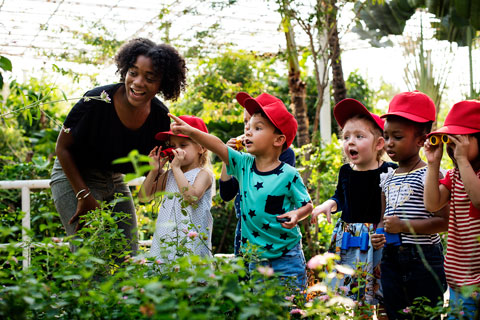Nature centers, parks, forest preserves, public gardens, working farms! Any of these places can become your preschool “classroom” during an outdoor field trip. Planning an outdoor field trip starts with deciding where to go.

Consider field trip logistics.
- Check your program’s field trip policies. Is travel by public transit, car, or school bus allowed? Are you able to collect money from families to pay for travel or other fees?
- Find out what adult/child ratio your program requires or recommends for field trips. How many volunteers will you need to help supervise the children?
- Consider how much travel time a field trip will require. How much time will the class actually be able to spend at their destination?
Anticipate what children might gain from an outdoor field trip.
- Keep in mind that children are likely to get more from a trip related to something they are studying than from a general-interest trip.
- Consider which early learning and development benchmarks might be met during the trip. Can children investigate weather or living things? What new vocabulary might they learn? Will they have opportunities to interact and be physically active?
- Be aware that children who don’t often go outdoors may need to focus on exploring the place and “discovering” nature. More experienced children may explore but may also concentrate on making detailed observations of specific things (trees, insects, a creek, etc.).
Collect information about places you might go.
- Find out as much as you can about key features of each place. What kinds of animals, plants, landforms, etc., will children be able to observe? Can they follow trails to points of interest? Are pathways wheelchair-accessible?
- Ask site personnel about services and facilities. Are restrooms and sources of water easy to find? Are guides available to answer children’s questions? Can teachers check out equipment such as insect nets and binoculars? Is a visitor center available? A playground?
- Find out about rules and regulations. Can children collect specimens? Is picnicking allowed?
Before you decide, visit possible sites.
- Go to each of the sites, preferably with other adults who will be involved, such as assistant teachers and parents. How do they feel about going there with children? Do benefits outweigh concerns about a trip?
- Take note of things that may interest, distract, or worry the children.
- Pick up print materials about each site. Take photographs or videos of what the children might see to share with the class before the trip.


 Printer-friendly PDF
Printer-friendly PDF PDF para imprimir
PDF para imprimir